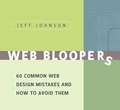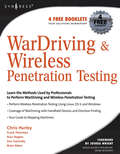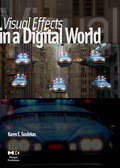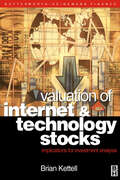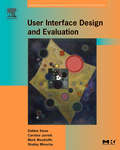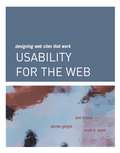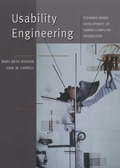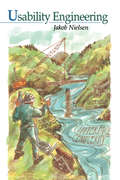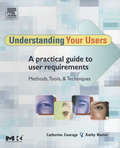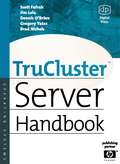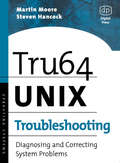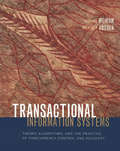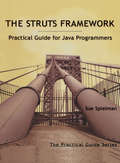- Table View
- List View
Web Services: Theory and Practice
by Anura GurugeThis is a soup-to-nuts reference guide on all aspects of Web Services - where Web Services is a fast emerging set of Internet-specific middleware technology to further promote the growth of all aspects of e-business via standardization, collaboration and "franchising." This book is best characterized as an executive brief for IT and senior management rather than a nuts-and-bolts technical guide for portal implementers. Think of it as the "Cliffs Notes on Web Services." Given this audience, the book consistently focuses on business needs, value propositions, ROI, proven solutions and actual examples of current implementations. Each chapter also ends with a 10-item "Q&A" section that consolidates and summarizes the information discussed in the chapter. The book is illustrated with detailed technical diagrams, includes lots of arresting subtitles and contains many bullet lists and tables to facilitate (and encourage) productive skimming. Decision makers - the intended readership for this book - gain increasing comfort and confidence as they get into the book that they are getting to see all facets of the issues, on a consistent basis, and that they will not be blind-sided at meetings by people asking 'difficult' questions. At the end of each chapter, Guruge summarizes and reinforces key points, allowing the reader to skim through the topics for crucial information. The book also leverages living outside resources and ensures that the readership always has ready and consistent access to any and all terms, definitions and concepts they might not be familiar with."Debate style" presentation, focusing repeatedly on pros-and-cons, e.g., .NET vs. Java, open vs. proprietary and buy vs. buildAuthor's trademark detailed architectural and network diagrams of portal implementationsQ&A section at end of each chapter
Web Services, Service-Oriented Architectures, and Cloud Computing (The Savvy Manager's Guides)
by Douglas K. BarryWeb services are leading to the use of more packaged software either as an internal service or an external service available over the Internet. These services, which will be connected together to create the information technology systems of the future, will require less custom software in our organizations and more creativity in the connections between the services. This book begins with a high-level example of how an average person in an organization might interact with a service-oriented architecture. As the book progresses, more technical detail is added in a "peeling of the onion" approach. The leadership opportunities within these developing service-oriented architectures are also explained. At the end of the book there is a compendium or "pocket library" for software technology related to service-oriented architectures.· Only web services book to cover both data management and software engineering perspectives, excellent resource for ALL members of IT teams· Jargon free, highly illustrated, with introduction that anyone can read that then leads into increasing technical detail· Provides a set of leadership principles and suggested application for using this technology.
Web Bloopers: 60 Common Web Design Mistakes, and How to Avoid Them (Interactive Technologies)
by Jeff JohnsonThe dot.com crash of 2000 was a wake-up call, and told us that the Web has far to go before achieving the acceptance predicted for it in '95. A large part of what is missing is quality; a primary component of the missing quality is usability. The Web is not nearly as easy to use as it needs to be for the average person to rely on it for everyday information, commerce, and entertainment.In response to strong feedback from readers of GUI BLOOPERS calling for a book devoted exclusively to Web design bloopers, Jeff Johnson calls attention to the most frequently occurring and annoying design bloopers from real web sites he has worked on or researched. Not just a critique of these bloopers and their sites, this book shows how to correct or avoid the blooper and gives a detailed analysis of each design problem. Hear Jeff Johnson's interview podcast on software and website usability at the University of Canterbury (25 min.)Discusses in detail 60 of the most common and critical web design mistakes, along with the solutions, challenges, and tradeoffs associated with them. Covers important subject areas such as: content, task-support, navigation, forms, searches, writing, link appearance, and graphic design and layout. Organized and formatted based on the results of its own usability test performed by web designers themselves.Features its own web site (www.web-bloopers.com)with new and emerging web design no-no's (because new bloopers are born every day) along with a much requested printable blooper checklist for web designers and developers to use.
WarDriving and Wireless Penetration Testing
by Frank Thornton Brian Baker Chris Hurley Russ RogersWireless networking has become standard in many business and government networks. This book is the first book that focuses on the methods used by professionals to perform WarDriving and wireless pentration testing.Unlike other wireless networking and security books that have been published in recent years, this book is geared primarily to those individuals that are tasked with performing penetration testing on wireless networks. This book continues in the successful vein of books for penetration testers such as Google Hacking for Penetration Testers and Penetration Tester’s Open Source Toolkit. Additionally, the methods discussed will prove invaluable for network administrators tasked with securing wireless networks. By understanding the methods used by penetration testers and attackers in general, these administrators can better define the strategies needed to secure their networks.* According to a study by the Strategis Group more than one third of the words population will own a wireless device by the end of 2008. * The authors have performed hundreds of wireless penetration tests, modeling their attack methods after those used by real world attackers. * Unlike other wireless books, this is geared specifically for those individuals that perform security assessments and penetration tests on wireless networks.
Visual Effects in a Digital World: A Comprehensive Glossary of over 7000 Visual Effects Terms (The Morgan Kaufmann Series in Computer Graphics)
by Karen GoulekasAs the visual effects industry has diversified, so too have the books written to serve the needs of this industry. Today there are hundreds of highly specialized titles focusing on particular aspects of film and broadcast animation, computer graphics, stage photography, miniature photography, color theory, and many others. Visual Effects in a Digital World offers a much-needed reconsolidation of this knowledge. All of the industry's workers frequently need to understand concepts from other specialties, and this book-the only one of its kind-lets them look up and grasp the basics of any visual effects concept in a matter of seconds. It's a great way for everyone, regardless of experience, to find their way through the jargon and learn what they need to know.Authoritative coverage from a winner visual effects expert-winner of a British Academy Award and two EmmysCovers topics such as computer graphics, digital compositing, live action, stage, and miniature photography, and a wide range of computer and Internet conceptsOffers job descriptions for positions found throughout the industryDemystifies the jargon used by practitioners in every subspecialty
Virtualization with Microsoft Virtual Server 2005
by Andy Jones Rogier Dittner David Rule Jr. Ken Majors Aaron Tiensivu Twan Grotenhuis Geoffrey GreenA virtual evolution in IT shops large and small has begun. Microsoft's Virtal Server is the enterprise tool to free an infrastructure from its physical limitations providing the transformation into a virtual environment--this book shows you how.This book will detail the default and custom installation of Microsoft's Virtual Server 2005, as well as basic and advanced virtual machine configurations. It will also discuss the requirements for a server virtualization and consolidation project and the cost savings surrounding such an effort. Furthermore, the book will provide a thorough understanding of the benefits of a virtual infrastructure and a comprehensive examination of how Virtual Server can ease administration and lower overall IT costs. Lastly, the book delivers a thorough understanding of the virtual evolution which is underway in many IT organizations and how the reader will benefit from shifting from the physical to a virtual world.* Examines in detail the default and custom installation of Microsoft's Virtual Server 2005* Addresses th important topics of server requirements and the cost implications involved* Looks at addressing IT costs and the benefits to the organisation
Valuation of Internet and Technology Stocks: Implications for Investment Analysis
by Brian KettellValuation of Internet and Technology Stocks offers practical information on how to value internet and high-tech companies more accurately. The book reviews previous practice, highlights the deficiencies in existing stock market techniques, and shows how to modify or replace them. It also demonstrates how the New Economics necessitates new forms of investment analysis. This book presents new ways of looking, researching and valuing internet and high-tech companies. It explains why there has been a high correlation between high loss companies and a rocketing stock price. It questions whether there is still a place for discounted cash flows when there is no cash flow to discount. It also considers what new methods are available to value super growth companies and whether these methods are any better than existing techniques. Chapters deal with a wide range of topics including: where technology/internet stocks fit in a new economy; how you value traditional common stocks; application of the Porter model to the valuation of technology/internet stocks; problems with applying traditional valuation models for technology/internet stocks; derivative markets and real options; and the lessons that can be learned by investors from the year 2000 collapse of technology/internet stocks. This text will be of interest to traders, investment managers, institutional investors, plan managers, and finance professionals.* Investigates why there has been a high correlation between high loss companies and a rocketing stock price* Questions whether there is still a place for discounted cash flows when there is no cash flow to discount* Considers what new methods are available to value super growth companies and whether these methods are any better than existing techniques
User Interface Design and Evaluation (Interactive Technologies)
by Debbie Stone Caroline Jarrett Mark Woodroffe Shailey MinochaUser Interface Design and Evaluation provides an overview of the user-centered design field. It illustrates the benefits of a user-centered approach to the design of software, computer systems, and websites. The book provides clear and practical discussions of requirements gathering, developing interaction design from user requirements, and user interface evaluation. The book's coverage includes established HCI topics—for example, visibility, affordance, feedback, metaphors, mental models, and the like—combined with practical guidelines for contemporary designs and current trends, which makes for a winning combination. It provides a clear presentation of ideas, illustrations of concepts, using real-world applications. This book will help readers develop all the skills necessary for iterative user-centered design, and provides a firm foundation for user interface design and evaluation on which to build. It is ideal for seasoned professionals in user interface design and usability engineering (looking for new tools with which to expand their knowledge); new people who enter the HCI field with no prior educational experience; and software developers, web application developers, and information appliance designers who need to know more about interaction design and evaluation.Co-published by the Open University, UK.Covers the design of graphical user interfaces, web sites, and interfaces for embedded systems.Full color production, with activities, projects, hundreds of illustrations, and industrial applications.
Usability for the Web: Designing Web Sites that Work (Interactive Technologies)
by Tom Brinck Darren Gergle Scott D. WoodEvery stage in the design of a new web site is an opportunity to meet or miss deadlines and budgetary goals. Every stage is an opportunity to boost or undercut the site's usability. Usability for the Web tells you how to design usable web sites in a systematic process applicable to almost any business need. You get practical advice on managing the project and incorporating usability principles from the project's inception. This systematic usability process for web design has been developed by the authors and proven again and again in their own successful businesses. A beacon in a sea of web design titles, this book treats web site usability as a preeminent, practical, and realizable business goal, not a buzzword or abstraction. The book is written for web designers and web project managers seeking a balance between usability goals and business concerns.Examines the entire spectrum of usability issues, including architecture, navigation, graphical presentation, and page structure.Explains clearly the steps relevant to incorporating usability into every stage of the web development process, from requirements to tasks analysis, prototyping and mockups, to user testing, revision, and even postlaunch evaluations.
Usability Engineering: Scenario-Based Development of Human-Computer Interaction (Interactive Technologies)
by John M. Carroll Mary Beth RossonYou don't need to be convinced. You know that usability is key to the success of any interactive system-from commercial software to B2B Web sites to handheld devices. But you need skills to make usability part of your product development equation. How will you assess your users' needs and preferences? How will you design effective solutions that are grounded in users' current practices? How will you evaluate and refine these designs to ensure a quality product? Usability Engineering: Scenario-Based Development of Human-Computer Interaction is a radical departure from traditional books that emphasize theory and address experts. This book focuses on the realities of product development, showing how user interaction scenarios can make usability practices an integral part of interactive system development. As you'll learn, usability engineering is not the application of inflexible rules; it's a process of analysis, prototyping, and problem solving in which you evaluate tradeoffs, make reasoned decisions, and maximize the overall value of your product.Written by prominent HCI educators who understand how to teach usability practices to students and professional developers.Interleaves HCI theory and concepts with a running case study demonstrating their application. Gradually elaborates the case study to introduce increasingly sophisticated usability engineering techniques.Analyzes usability issues in realistic scenarios that describe existing or envisioned systems from the perspective of one or more users.Emphasizes the real world of usability engineering-a world in which tradeoffs must be weighed and difficult decisions made to achieve desired results.
Usability Engineering (Interactive Technologies)
by Jakob NielsenWritten by the author of the best-selling HyperText & HyperMedia, this book is an excellent guide to the methods of usability engineering. The book provides the tools needed to avoid usability surprises and improve product quality. Step-by-step information on which method to use at various stages during the development lifecycle are included, along with detailed information on how to run a usability test and the unique issues relating to international usability.* Emphasizes cost-effective methods that developers can implement immediately* Instructs readers about which methods to use when, throughout the development lifecycle, which ultimately helps in cost-benefit analysis. * Shows readers how to avoid the four most frequently listed reasons for delay in software projects.* Includes detailed information on how to run a usability test.* Covers unique issues of international usability.* Features an extensive bibliography allowing readers to find additional information.* Written by an internationally renowned expert in the field and the author of the best-selling HyperText & HyperMedia.
UNIX for OpenVMS Users (HP Technologies)
by Philip Bourne Richard Holstein Joseph McMullenUNIX for OpenVMS Users, 3E, makes it easy to see what OpenVMS and UNIX have in common, and to transfer your knowledge and experience in OpenVMS over to the world of UNIX. Since most shops rely on more than one operating system, it is critical for system administrators and managers to understand the similarities and differences between platforms, so they can easily work in both environments while taking full advantage of the tools and applications available on each. This book offers OpenVMS professionals a concise source of information, so that they can quickly bring their expertise to bear on UNIX file management, e-mail, networking, and security. This new edition of the book is enhanced with updated references to VMS, incorporates suggestions made by readers of previous editions, and particularly, recognizes other UNIX implementations in addition to HP's Tru64.Includes extensive additions to the sections on VMS logical names, on the emacs editor, and on shell programming and PerlDescribes the interfaces common to both operating systems, with appendices covering command and editor summariesAdds emphasis on Linux
Unit Testing in Java: How Tests Drive the Code (The Morgan Kaufmann Series in Software Engineering and Programming)
by Johannes LinkSoftware testing is indispensable and is one of the most discussed topics in software development today. Many companies address this issue by assigning a dedicated software testing phase towards the end of their development cycle. However, quality cannot be tested into a buggy application. Early and continuous unit testing has been shown to be crucial for high quality software and low defect rates. Yet current books on testing ignore the developer's point of view and give little guidance on how to bring the overwhelming amount of testing theory into practice. Unit Testing in Java represents a practical introduction to unit testing for software developers. It introduces the basic test-first approach and then discusses a large number of special issues and problem cases. The book instructs developers through each step and motivates them to explore further.Shows how the discovery and avoidance of software errors is a demanding and creative activity in its own right and can build confidence early in a project. Demonstrates how automated tests can detect the unwanted effects of small changes in code within the entire system.Discusses how testing works with persistency, concurrency, distribution, and web applications.Includes a discussion of testing with C++ and Smalltalk.
Understanding WMI Scripting: Exploiting Microsoft's Windows Management Instrumentation in Mission-Critical Computing Infrastructures (HP Technologies)
by Alain LissoirUnderstanding WMI Scripting explains to Windows and Exchange Administrators how they can use the Windows Management Instrumentation (WMI) scriptable technology available in these products to ease their day-to-day management tasks. Under Windows.NET and Exchange 2000 (SP2), Microsoft is making solid enhancements in WMI. This will dramatically extend the scripting and manageability capabilities of Windows and Exchange. Illustrated with more than three hundred samples, the book links practical problems encountered by administrators to applicable scriptable solutions. Lissoir focuses not on MI programming aspects for developers but on how administrators can use what is available in Windows and Exchange for their admin work. WMI is a very important topic under Windows.NET and Exchange 2000 (SP2), so this book provides real added value to Windows/Exchange administrators. Although Exchange relies on Windows, no other book combines coverage of Windows and Exchange.· Fine tune management of Windows servers· Achieve better system management and customize critical operations· Access hundreds of usable scripts in book and downloadable from web
Understanding Virtual Reality: Interface, Application, and Design (The Morgan Kaufmann Series in Computer Graphics)
by William R. Sherman Alan B. CraigUnderstanding Virtual Reality arrives at a time when the technologies behind virtual reality have advanced to the point that it is possible to develop and deploy meaningful, productive virtual reality applications. The aim of this thorough, accessible exploration is to help you take advantage of this moment, equipping you with the understanding needed to identify and prepare for ways VR can be used in your field, whatever your field may be.By approaching VR as a communications medium, the authors have created a resource that will remain relevant even as the underlying technologies evolve. You get a history of VR, along with a good look at systems currently in use. However, the focus remains squarely on the application of VR and the many issues that arise in the application design and implementation, including hardware requirements, system integration, interaction techniques, and usability. This book also counters both exaggerated claims for VR and the view that would reduce it to entertainment, citing dozens of real-world examples from many different fields and presenting (in a series of appendices) four in-depth application case studies.* Substantive, illuminating coverage designed for technical and business readers and well-suited to the classroom.* Examines VR's constituent technologies, drawn from visualization, representation, graphics, human-computer interaction, and other fields, and explains how they are being united in cohesive VR systems.* Via a companion Web site, provides additional case studies, tutorials, instructional materials, and a link to an open-source VR programming system.
Understanding Your Users: A Practical Guide to User Requirements Methods, Tools, and Techniques (Interactive Technologies)
by Kathy Baxter Catherine CourageToday many companies are employing a user-centered design (UCD) process, but for most companies, usability begins and ends with the usability test. Although usability testing is a critical part of an effective user-centered life cycle, it is only one component of the UCD process. This book is focused on the requirements gathering stage, which often receives less attention than usability testing, but is equally as important. Understanding user requirements is critical to the development of a successful product. Understanding Your Users is an easy to read, easy to implement, how-to guide on usability in the real world. It focuses on the "user requirements gathering" stage of product development and it provides a variety of techniques, many of which may be new to usability professionals. For each technique, readers will learn how to prepare for and conduct the activity, as well as analyze and present the data —all in a practical and hands-on way. In addition, each method presented provides different information about the user and their requirements (e.g., functional requirements, information architecture, task flows). The techniques can be used together to form a complete picture of the users’ requirements or they can be used separately to address specific product questions. These techniques have helped product teams understand the value of user requirements gathering by providing insight into how users work and what they need to be successful at their tasks. Case studies from industry-leading companies demonstrate each method in action. In addition, readers are provided with the foundation to conduct any usability activity (e.g., getting buy-in from management, legal and ethical considerations, setting up your facilities, recruiting, moderating activities) and to ensure the incorporation of the results into their products.·Covers all of the significant requirements gathering methods in a readable, practical way·Presents the foundation readers need to prepare for any requirements gathering activity and ensure that the results are incorporated into their products ·Includes invaluable worksheet and template appendices·Includes a case study for each method from industry leaders·Written by experienced authors who teach conference courses on this subject to usability professionals and new product designers alike
Understanding and Servicing Alarm Systems
by H. William TrimmerUnderstanding and Servicing Alarm Systems, Third Edition has seen the alarm industry enter the computer age. With its coverage of microcomputerized controls, sophisticated detection devices, methods of alarm reporting, that second edition broke new ground. Now completely updated to reflect the security industry's most high-tech advances, the third edition of Understanding and Servicing Alarm Systems, continues on the road of educating the alarm dealer, installer, and technician. Prepares readers for the practicalities of dealing with customers Takes readers from the basics of electricity to the most modern equipment installation and repair Teaches the pitfalls one might encounter in the alarm servicing profession, along with the approaches for troubleshooting
TruCluster Server Handbook (HP Technologies)
by Scott Fafrak Jim Lola Dennis O'Brien Gregory Yates Brad NicholsThe TruCluster Server Handbook authoritatively details how to plan, design, install, configure, and administer a cluster of Tru64 UNIX systems. The book explains how to configure and optimize hardware underlying a TruCluster server, including storage servers so critical to running a high-end cluster operation. This book provides best practices and techniques drawn from the authors' extensive experiences in the field with systems designers, systems managers, developers, and users. The authors include a former Tru64 UNIX Technical Group Leader with HP's Consulting Division and a top industry figure, and two former TruCluster Server Team Leaders with the Customer Support Center.Learn to install TruCluster Server from the ground upGet the most out of your cluster environment with the authors' practical tips and tricksAttain availability, scalability, and simplified manageability in your IT systems operation
Tru64 UNIX Troubleshooting: Diagnosing and Correcting System Problems (HP Technologies)
by Martin Moore Steven HancockDealing with system problems—from user login failures to server crashes--is a critical part of a system administrator's job. A down system can cost a business thousands of dollars per minute. But there is little or no information available on how to troubleshoot and correct system problems; in most cases, these skills are learned in an ad-hoc manner, usually in the pressure-cooker environment of a crisis. This is the first book to address this lack of information.The authors (both experienced Tru64 UNIX support engineer for Compaq) systematically present the techniques and tools needed to find and fix system problems. The first part of the book presents the general principles and techniques needed in system troubleshooting. These principles and techniques are useful not only for UNIX system administrators, but for anyone who needs to find and fix system problems. After this foundation, the authors describe troubleshooting tools used in the UNIX environment. The remainder of the book covers specific areas of the Tru64 UNIX operating system in detail: listing common problems, their causes, how to detect them, and how to correct them. Each chapter includes a "Before You Call Support" section that details the most important things to check and correct before it's necessary to call Compaq technical support. The authors also include decision trees to help the reader systematically isolate particular problem types.· "Before You Call Tech Support" sections· Tables and diagrams for quick access to precise data· Decision trees to help choose the best way to troubleshoot a particular problem
Trojans, Worms, and Spyware: A Computer Security Professional's Guide to Malicious Code
by Michael ErbschloeTrojans, Worms, and Spyware provides practical, easy to understand, and readily usable advice to help organizations to improve their security and reduce the possible risks of malicious code attacks. Despite the global downturn, information systems security remains one of the more in-demand professions in the world today. With the widespread use of the Internet as a business tool, more emphasis is being placed on information security than ever before. To successfully deal with this increase in dependence and the ever growing threat of virus and worm attacks, Information security and information assurance (IA) professionals need a jargon-free book that addresses the practical aspects of meeting new security requirements. This book provides a comprehensive list of threats, an explanation of what they are and how they wreak havoc with systems, as well as a set of rules-to-live-by along with a system to develop procedures and implement security training. It is a daunting task to combat the new generation of computer security threats – new and advanced variants of Trojans, as well as spyware (both hardware and software) and “bombs" – and Trojans, Worms, and Spyware will be a handy must-have reference for the computer security professional to battle and prevent financial and operational harm from system attacks.*Provides step-by-step instructions to follow in the event of an attack *Case studies illustrate the "do's," "don'ts," and lessons learned from infamous attacks *Illustrates to managers and their staffs the importance of having protocols and a response plan in place
Transactional Information Systems: Theory, Algorithms, and the Practice of Concurrency Control and Recovery (The Morgan Kaufmann Series in Data Management Systems)
by Gerhard Weikum Gottfried VossenTransactional Information Systems is the long-awaited, comprehensive work from leading scientists in the transaction processing field. Weikum and Vossen begin with a broad look at the role of transactional technology in today's economic and scientific endeavors, then delve into critical issues faced by all practitioners, presenting today's most effective techniques for controlling concurrent access by multiple clients, recovering from system failures, and coordinating distributed transactions. The authors emphasize formal models that are easily applied across fields, that promise to remain valid as current technologies evolve, and that lend themselves to generalization and extension in the development of new classes of network-centric, functionally rich applications. This book's purpose and achievement is the presentation of the foundations of transactional systems as well as the practical aspects of the field what will help you meet today's challenges.Provides the most advanced coverage of the topic available anywhere--along with the database background required for you to make full use of this material.Explores transaction processing both generically as a broadly applicable set of information technology practices and specifically as a group of techniques for meeting the goals of your enterprise.Contains information essential to developers of Web-based e-Commerce functionality--and a wide range of more "traditional" applications.Details the algorithms underlying core transaction processing functionality.
Transaction Processing: Concepts and Techniques (The Morgan Kaufmann Series in Data Management Systems)
by Jim Gray Andreas ReuterThe key to client/server computing. Transaction processing techniques are deeply ingrained in the fields ofdatabases and operating systems and are used to monitor, control and updateinformation in modern computer systems. This book will show you how large,distributed, heterogeneous computer systems can be made to work reliably.Using transactions as a unifying conceptual framework, the authors show howto build high-performance distributed systems and high-availabilityapplications with finite budgets and risk.The authors provide detailed explanations of why various problems occur aswell as practical, usable techniques for their solution. Throughout the book,examples and techniques are drawn from the most successful commercial andresearch systems. Extensive use of compilable C code fragments demonstratesthe many transaction processing algorithms presented in the book. The bookwill be valuable to anyone interested in implementing distributed systemsor client/server architectures.
Tony Redmond's Microsoft Exchange Server 2003: with SP1 (HP Technologies)
by Tony RedmondWith over 40% new and revised material throughout the book, this updated version provides thorough coverage of implementation, migration and management issues for Exchange 2000 and 2003, all backed up by best practices developed by HP, Microsoft’s only world-wide Prime Integrator for Exchange. The best and most comprehensive coverage of Exchange from the Chief Technology Officer of HP Services, Microsoft’s only worldwide Prime Integrator for Windows and Exchange.- With over 40% new and revised material throughout the book, this updated version provides thorough coverage of implementation, migration and management issues for Exchange 2000 and 2003, all backed up by best practices developed by HP, Microsoft's only world-wide Prime Integrator for Exchange. - New coverage of Exchange Intelligent Message Filter- Revised and updated coverage of best practices for the design, deployment, and operation of Exchange 2003 - Comprehensive treatment of major issues facing email deployments, including anti-virus and anti-spam techniques - Review of Microsoft's future strategy for Exchange since dropping the Kodiak approach
The System Engineers Handbook (ISSN)
by John BlackThe System Engineer's Handbook, written by the developer of the VME bus system and some of the most knowledgeable experts in the computer industry, is the most comprehensive guide available for the VME bus standard. It is the system engineer's guide to building high performance multiprocessor systems. This book contains complete copies of VME bus and VXI bus specifications and applications information, enabling a system engineer to purchase state-of-the-art board components from specialized manufacturers and assemble them into a fully-functional system.
The Struts Framework: Practical Guide for Java Programmers (The Practical Guides)
by Sue SpielmanStruts is an open-source framework that integrates with standard Java technologies and lets developers build web applications quickly and effectively. In much the same way that Java has overtaken C++, Struts is well poised to become the framework for web application development because of its ability to address the types of issues engineers face when building large-scale web applications. The Struts Framework: Practical Guide for Java Programmers meets the needs of this large audience--estimated today at 2.5 million Java programmers and growing. It provides the systematic exploration required by newcomers as well as the step-by-step instruction for more experienced readers eager to exploit Struts to the fullest. Devoted to the latest version of the framework (v. 1.1) and vividly illustrated with a thorough sample application throughout, this book is an essential resource for all programmers who want to be part of the next stage in the evolution of the web.Hard-to-find, practical coverage from a highly visible figure in the Java development world.Among the first books to cover the latest release of Struts, version 1.1.Reviews all the technologies comprising Struts, including JavaServer Pages, Servlets, XML, Custom Tags, and web and application servers.Teaches readers the development practices-including design, debugging, internationalization, and implementation-essential to Struts development.


